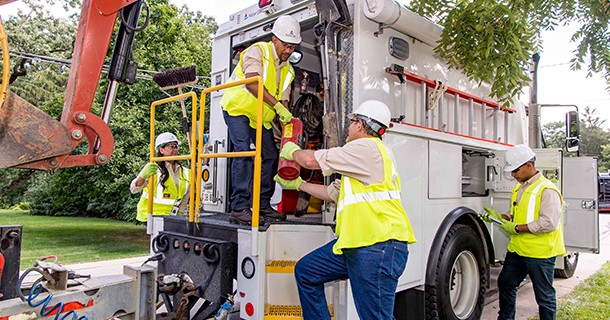Distributed Generation
Creating energy right where it will be used is highly efficient. Distributed generation saves money on power bills, supplements electricity from the electric grid and helps meet your need for power reliability. Learn more about DG technology—natural gas industrial gas turbines, reciprocating engines and microturbines or contact us at gasadvantage@aglresources.com or 800.427.5463. Choose option 4.
Industrial Gas Turbines
The use of natural gas-fueled turbines is growing among industrial plant operators as well as large commercial energy users and institutions, such as hospitals and universities. Gas turbines are also the heart of Combined Heat-and-Power (CHP) systems.
Major process industries—primarily chemicals, paper, and oil and gas—have been using large turbine CHP systems (over 25 MW) for some time. Now the economics of smaller turbine systems (1 to 10 MW) have recently become more attractive.
Natural gas turbines include higher power ratings and efficiencies, advanced controls, lower emissions of nitrogen oxides (NOx) and lower lifecycle costs.
Natural gas turbines can be operated in three ways:
- Simple cycle turbines use an air-compression section, a burner and a power turbine driving a load, such as a generator for producing electricity. The turbine's high temperature exhaust heat can be used to produce process steam.
- Recuperated turbines incorporate a heat exchanger, which recovers heat from the turbine exhaust to preheat the compressed air before it enters the burner.
- Combined-cycle turbine systems use exhaust heat to produce steam to drive a second turbine, which produces additional electricity. Most combined-cycle systems are larger than industrial-scale plants.
Today's turbines reach efficiencies of 30 to 40 percent or greater. In CHP systems with heat recovery, overall thermal efficiencies of 70 to 80 percent are common, and 90 percent is achievable.
Air emissions from gas turbines have decreased substantially. Early systems used water or steam injection to reduce flame temperature and control NOx emissions. Manufacturers now offer "dry" low-NOx combustors without water or steam, which reduce NOx emissions to 25 parts per million or lower.
Energy Solutions Center: Industrial Turbines
Gas Technology Magazine: Gas Turbines Spell Opportunity for Industry
Reciprocating Engines
Reciprocating engines are the fastest-selling, lowest-cost form of DG. They can be used in a variety of applications due to their small size, low unit cost and useful thermal output.
Reciprocating engines are available commercially in sizes from .5 kW to 6.5 MW, suitable for a wide range of commercial, industrial and institutional applications. These applications include continuous power generation, peak shaving, back-up power, standby power and mechanical drive use.
Reciprocating engines also offer heat recovery potential. They make up a large portion of the cogeneration market in the United States.
Microturbines
Microturbines are essentially miniature jet engines connected to small generators to produce electricity. They have very sophisticated electronic systems, which allow them to provide safe and efficient operation by consistently monitoring themselves. Easy to install, they have low emissions.
Microturbines most frequently are used during peak electricity time periods so companies can avoid high demand charges. They are particularly cost effective when used in CHP systems that capture waste heat from the exhaust. The exhaust heat, which is about 600 degrees Fahrenheit, can be used for heating, cooling, water heating or preheat boiler applications.



